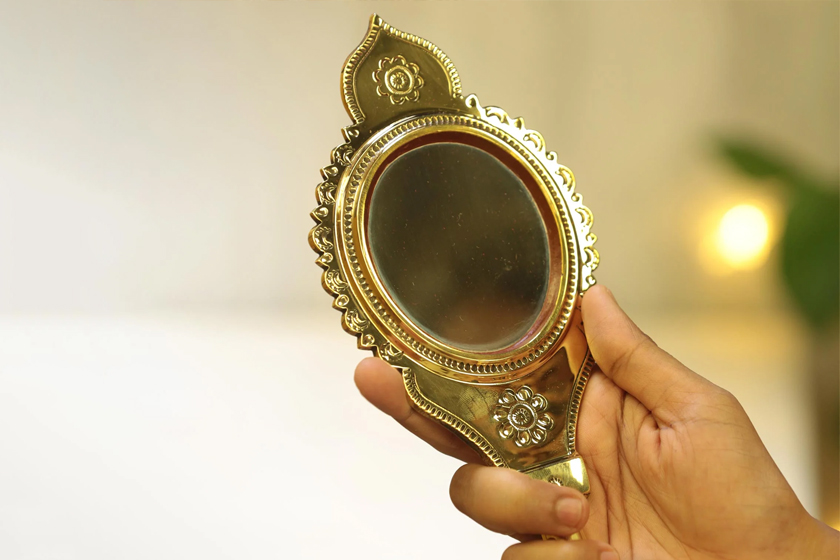
Our Products Include
- Aranmula Kannadi
- Kerala Mural Art Canvas Painting
- Nettipattam
Fabrikee is dedicated to displaying an exceptional collection of traditional arts and crafts that has been transformed into a stunning array of contemporary products. Our products are a testimony to the rich culture of Indian craftsmanship, where myths, legends, and everyday life combine to create a vibrant expression of creativity. This creativity is not static, but it evolves daily while preserving its essence through centuries, enriching the lives of both creators and patrons.

Aranmula Kannadi
The Emblem of Heritage and Prosperity
Aranmula Kannadi, also known as Aranmula Metal Mirror, is a unique type of mirror that is traditionally made in Aranmula, a village in Kerala, India. What makes these mirrors special is the way they are crafted and the materials used.
Unlike conventional mirrors that are made of glass, Aranmula Kannadi is made of a special combination of metals, including copper, tin, and bronze. These metals are carefully alloyed in specific proportions to achieve the desired reflective surface. The mirror is then meticulously polished to perfection by skilled artisans.
What's fascinating about Aranmula Kannadi is its distortion-free reflection. Unlike regular mirrors, which use a coating of silver or aluminum on the back of glass, Aranmula Kannadi relies solely on the purity of its metal composition and the craftsmanship involved in its making. This unique method results in a mirror that reflects true-to-life images without any distortions.
Aranmula Kannadi holds great cultural and religious significance in Kerala. It is often considered a symbol of prosperity and good luck, and it is traditionally gifted during auspicious occasions like weddings and housewarming ceremonies.
The process of making Aranmula Kannadi is closely guarded and passed down through generations within specific families in Aranmula. Due to its intricate craftsmanship and cultural significance, Aranmula Kannadi has gained recognition and popularity not only in India but also internationally as a prized decorative item and collector's piece.
Kerala Mural Art Canvas Painting
Kerala mural paintings are a majestic form of art, where the walls and ceilings serve as the canvas for narratives of divine mythology. Historically, these murals are renowned for their precision and integration with architectural elements, where every stroke and color choice are deliberate, enhancing the overall aesthetic of the sacred spaces they adorn.
Today, while these traditional murals primarily adorned the walls of temples and palaces, modern adaptations have seen these historic techniques transferred onto canvas and paper, making them accessible and preserving their ethereal beauty. The pigments used are derived from natural resources—minerals and plants—featuring vibrant hues like saffron-red, emerald, green, and deep blues, contributing to their distinctive, vivid appearance. Mural paintings can serve many purposes, from conveying a message or story to beautifying a space or expressing cultural identity.
Many cities around the world have embraced the idea of using murals to revitalize neighbourhood’s, promote social causes, or simply add aesthetic value to public spaces. Additionally, mural festivals and events have become common, bringing together artists from different backgrounds to collaborate and create stunning works of art.
Overall, mural painting is a versatile and powerful art form that continues to evolve and inspire both artists and audiences alike.


NETTIPATTAM
Nettipattam is a traditional ornament used in Kerala, India. It's a decorative headdress or headgear adorned with colourful beads, stones, and sometimes small mirrors. Typically, it's worn by decorated elephants during festivals, processions, and other cultural events in Kerala. The nettipattam adds to the majestic appearance of the elephants and is often considered a symbol of grandeur and auspiciousness. It's fascinating how such ornate pieces are integral to cultural festivities, adding vibrancy and tradition to the celebrations.